

Pietro di Nicola Baroni, who was born in Orvieto, seems to have been strongly influenced by the fresco (1425) of the Madonna and Child enthroned by Gentile da Fabriano in the nave of the Duomo of Orvieto. The earliest documentary record of him is in Perugia, in 1436-9 (see below). This might have been because his relative, a Benedictine monk and expert in stained glass called Francesco Baroni, was based there.
His great opportunity came in 1447, when he was added to the team of Fra Angelico that worked on the frescoes of the Cappella Nuova in the Duomo of his native city (see below). He was considered for, but not given, the job of completing the work when Fra Angelico failed to honour the last two years of his three-year contract. He was however, well-regarded in his native city, particularly in his old age. He was, for example, consulted on:
-
✴the valuation of the value of the of the polyptych that Pier Matteo d’ Amelia painted for Sant’ Agostino in 1481; and
-
✴the decision to appoint Perugino to complete the frescoes of the Cappella Nuova of the Duomo in 1489.
Orvieto
Frescoes (ca. 1430)

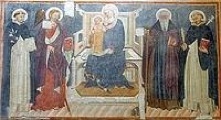
Two frescoes in the Cappella di San Pietro Martire of San Domenico are attributed to Pietro di Nicola Baroni:
-
✴the Martyrdom of St Peter Martyr (ca. 1430), to the left on the left wall, which depicts the murder of the saint and his companion; and
-
✴the fresco (1430), to the right on the left wall, which is dated by inscription, and which depicts the Madonna and Child enthroned and:
-
•St Dominic (carrying the lily of purity);
-
•St James (with his pilgrim's staff);
-
•St Antony Abbot (with his pig); and
-
•St Peter Martyr (with the knife that killed him still in his back).
Vault of Cappella Nuova, Duomo (1447)
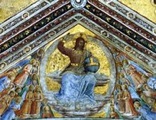
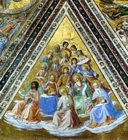
Christ in Judgment Prophets
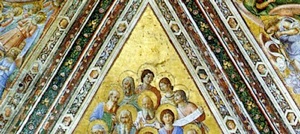
Detail of decoration of the ribs
In 1446, probably at the behest of the brothers Gentile and Arrigo Monaldeschi della Vipera (who ruled Orvieto in the period 1435-49), the Opera del Duomo commissioned Fra Angelico to begin the decoration of the Cappella Nuova of the Duomo. The contract, which required Fra. Angelico to spend three months each summer in 1447-9 in Orvieto, described him as ‘famosus ultra omnes pictores italicos’ (more famous than any other artist in Italy). He arrived in Orvieto in June, together with his assistant Benozzo Gozzoli and two apprentices, and the Opera del Duomo put Pietro di Nicola Baroni at his disposal.
Fra Angelico and his team frescoed two of the four sections of the vault nearest the altar, which depicted:
-
✴Christ in Judgment; and
-
✴the Prophets.
The heads in hexagons on the ribs of the vaults are attributed to Pietro di Nicola Baroni.
Fra Angelico left Orvieto for Rome in September 1447, as allowed for in his three-year contract. However, the demand for his services from Pope Nicholas V meant that he never returned, albeit that some minor work was subsequently carried out by Pietro di Nicola Baroni and other assistants. Pietro di Nicola Baroni offered to take over from Fra Angelico in May 1449, but this offer was not taken up. Work probably stopped completely in December 1449, when Arrigo Monaldeschi was murdered and Gentile was driven into exile.
Pietà with SS Faustinus and Peter Parenzo (1468)
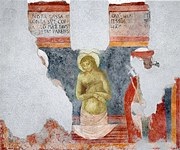
This documented fresco by Pietro di Nicola Baroni was in the Cappellina dei Corpi Santi, a small chapel on the right of the Cappella Nuova in the Duomo. (The small chapel was so-called because it had contained the relics of St Faustinus and St Peter Parenzo from 1421). The inscription above the main scene, which is in two columns, commemorates SS Faustino and Peter Parenzo, intercessors for the city, whose bodies lay in the “cassa dei corpi santi” in the chapel. It reads:
IN ISTA CASSA R[E]
CONDITA SUNT CORP[O]
RA SANCTORUM MARTIRUM FAUST
[INI] ET PETRY PARENS[I]
QUORUM MERITIS INTER
CESSIONIBUS DEUS [CIVITATEM]
HANC [ELUIT] [...]
This fresco, which depicted the two saints flanking an image of the Pietà, was covered by a wall in 1502-3, but recovered and detached during the restoration of the chapel in 1996. It is now in the Museo dell' Opera del Duomo.
Maestà (1474)
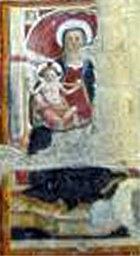
Frescoes in San Giovenale (15th century)
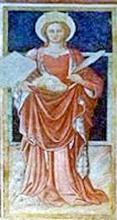
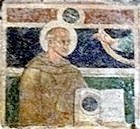
The following frescoes in San Giovenale are attributed to Pietro di Nicola Baroni:
St Catherine of Alexandria
This detached fresco in the apse (to the right on the back wall), which depicts St Catherine holding her own severed head and a palm of martyrdom, has been recently restored.
St Bernardino of Siena
In this fresco is on the right wall (at the top of the steps), St Bernardino holds a book open at a page with a depiction of the symbol IHS (the Holy Name of Christ), and the hand of Christ appears at the upper left left. Thus Christ recognises the controversial “IHS” as an alternative to the sign of the Cross.
St Bernardino (15th century)
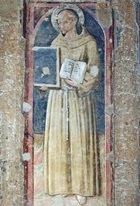
Frescoes in Santa Maria dei Servi (15th century)
The following frescoes in Santa Maria dei Servi are attributed to Pietro di Nicola Baroni:
Madonna and Child
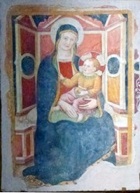
Frescoes in the Cappella del Crocifisso
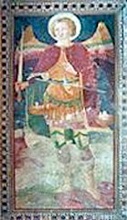
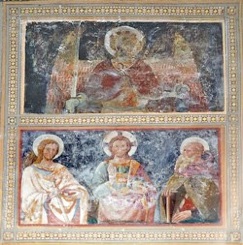
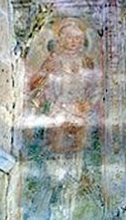
St Michael St Michael (above) St George
Christ blessing with SS James and Antony Abbot
(left wall) (back wall) (right wall)
These damaged frescoes are in the Cappella del Crocifisso. The inscription on the fresco of Christ with saints states that He rules "Asya, Africa, Europa".
[Crucifixion
This fresco is in the sacristy.]
Frescoes in Santo Stefano (15th century)
The following frescoes in Santo Stefano are attributed to Pietro di Nicola Baroni:
Madonna and Child
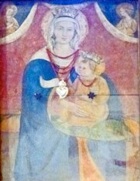
Fragment of a Crucifixion

Madonna in Morto Vivo (15th century)
Perugia
In 1436, the Confraternita di Sant’ Agostino made a payment to Pietro di Nicolà for a Pietà, but this no longer survives. He is also documented in the archives of the Arte della Lana in 1437 and 1439.
Panels from a Polyptych (15th century)
These panels came from a polyptych in the Sylvestrine nunnery of San Benedetto (now Sant’ Erminio). The central panel of the Madonna and Child with two kneeling angels is signed “Petri Urbevetere opus” (the work of Peter of Orvieto, usually identified as Pietro di Nicola Baroni). The other surviving panels are:
-
✴two side panels depicting:
-
•St Benedict, with a smaller figure of a kneeling monk (presumably the donor) in front of him; and
-
•St Jerome, with his lion and cardinal’s hat;
-
✴three cusp panels depicting:
-
•God the Father, above the central panel; and
-
•the figures of the Annunciation; and
-
✴three predella panels, depicting:
-
•SS Benedict, Maurus and Placidus;
-
•the Pietà (at the centre); and
-
•St Sylvester Gozzolini (the founder of the Sylvestrine Congregation) saving a monk.
The panels passed to the Oddi family, presumably when they acquired the premises of the nunnery in 1641. They are now in the Museum of Western and Oriental Art, Kiev, and are illustrated in the site of the Fondazione Federico Zeri.
Madonna and Child with saints (15th century)
This polyptych from the Camaldolesian Monastero della SS Trinità, which is attributed to Pietro di Nicola Baroni, was taken to San Severo in 1793 and is now in the Galleria Nazionale. It depicts the Madonna and Child and SS Catherine of Alexandria, Benedict, John the Baptist and Severus in the panels to the sides. The predella panels depict SS Louis of Toulouse, Romuald, Francis and Rinaldo: the central predella panel has been lost. The polyptych is illustrated in the site of the Fondazione Federico Zeri.
Read more:
G. Testa, “La Cappellina dei Corpi Santi e la Cappellina della Maddalena”, in:
G. Testa (Ed.), “La Cappella Nuova o di San Brizio nel Duomo di Orvieto”, (1996) Milan, pp 269-76
(The material here on Pietro di Nicola Baroni is principally on pp 270-3)

